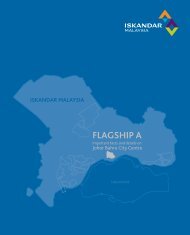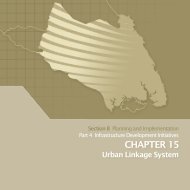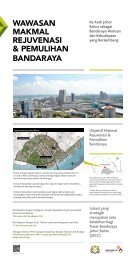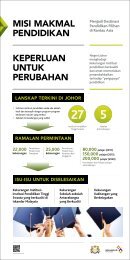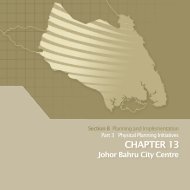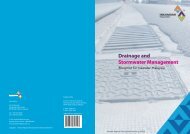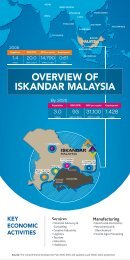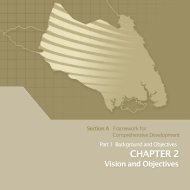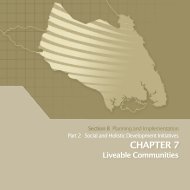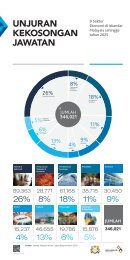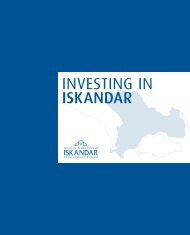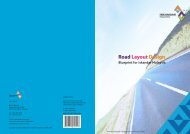Area Character Statement - Iskandar Malaysia
Area Character Statement - Iskandar Malaysia
Area Character Statement - Iskandar Malaysia
Create successful ePaper yourself
Turn your PDF publications into a flip-book with our unique Google optimized e-Paper software.
ISBN 978-967-5626-24-1<br />
<strong>Area</strong> <strong>Character</strong> <strong>Statement</strong>
<strong>Area</strong> <strong>Character</strong> <strong>Statement</strong><br />
Blueprint for <strong>Iskandar</strong> <strong>Malaysia</strong>
ACKNOWLEDGEMENT<br />
List of agencies/ departments involved in developing ACS blueprint<br />
Federal<br />
Ministry of Information, Communication & Culture (KPKK)<br />
Badan Warisan <strong>Malaysia</strong><br />
Jabatan Pembangunan Bandar dan Desa (JPBD) Johor<br />
State<br />
Chief Minister of Johor Office<br />
Yayasan Warisan Johor<br />
Majlis Bandaraya Johor Bahru (MBJB)<br />
Majlis Perbandaran Johor Bahru Tengah (MPJBT)<br />
Majlis Perbandaran Pasir Gudang (MPPG)<br />
Majlis Perbandaran Kulai (MPK)<br />
Majlis Daerah Pontian (MDP)<br />
Majlis Tindakan Pelancongan Johor<br />
Tourist Guide Associations<br />
Historians<br />
Local Community
Foreword<br />
<strong>Iskandar</strong> <strong>Malaysia</strong> is a National Project to develop a vibrant new region at the southern gateway of<br />
Peninsular <strong>Malaysia</strong>. A regional authority body <strong>Iskandar</strong> Regional Development Authority (IRDA) was<br />
formed with specific roles to plan, promote and facilitate in which to coordinate the economic,<br />
environmental and social planning, development and management of <strong>Iskandar</strong> <strong>Malaysia</strong>. IRDA refers to<br />
The Comprehensive Development Plan (CDP) as the guiding document in developing <strong>Iskandar</strong><br />
<strong>Malaysia</strong>, and subsequent to that, blueprints are prepared as a subset and supplementary document to<br />
CDP, which outlines detail findings, strategies, implementation and action plans.<br />
The <strong>Iskandar</strong> <strong>Malaysia</strong> <strong>Area</strong> <strong>Character</strong> <strong>Statement</strong> blueprint has been prepared to assist the public and<br />
private sector and the community to work together in managing heritage and cultural concerns within<br />
the <strong>Iskandar</strong> <strong>Malaysia</strong> region so that all can benefit in making the region a place to invest, work, live and<br />
play. The document is a non-statutory document that identifies the distinctive qualities and<br />
characteristics of <strong>Iskandar</strong> <strong>Malaysia</strong>, and suggests how they can be preserved and enhanced through<br />
proposed programs or project proposals as well as relevant guidelines.<br />
The Blueprint focuses on <strong>Area</strong> <strong>Character</strong> Planning addresses issues of design and character and involves<br />
more than looking at just the physical layout of development or the amount of open space to be<br />
provided. Therefore the study of an area character can be understood as a study that describes the<br />
distinctive qualities and characteristics of an area. This blueprint has twenty-five (25) initiatives and<br />
action plans to manage future <strong>Area</strong> <strong>Character</strong> planning in <strong>Iskandar</strong> <strong>Malaysia</strong>.<br />
The key objectives underpinning in this study are : to ensure that the historical and cultural aspect of<br />
the state are preserved, promoted and enhanced, and not lost amidst the on going anticipated modern<br />
development of <strong>Iskandar</strong>; to develop identity for <strong>Iskandar</strong> <strong>Malaysia</strong> by understanding the historical<br />
events that shape southern Johor since its beginning, that can contribute to the overall character of<br />
<strong>Iskandar</strong> and promoting <strong>Iskandar</strong> as a unique place to live, work, play and do business; and to ensure a<br />
well managed system of implementation of proposed enhancement and preservation of all <strong>Iskandar</strong><br />
identity and character, which includes stakeholder engagement and public participation.
CONTENT<br />
1.0 PROJECT DESCRIPTION 1<br />
1.1 Definition 1<br />
1.2 The Study 1<br />
1.3 Objective of the Study 1<br />
1.4 Targeted User 1<br />
1.5 Identification of <strong>Character</strong> 2<br />
2.0 STAKEHOLDERS INVOLVEMENT 2<br />
2.1 Stakeholders 2<br />
2.2 Workshops 3<br />
3.0 ELEMENTS OF CHARACTER 3<br />
3.1 Natural Elements 3<br />
3.2 Man-made Elements (including Built Heritage) 6<br />
3.3 Social & Cultural Elements 7<br />
4.0 ASSETS AND POTENTIALS 9<br />
5.0 ISSUES AND THREATS 10<br />
5.1 Nature 10<br />
5.2 Urban Design 11<br />
5.3 Built Heritage 11<br />
5.4 Society & Culture 11<br />
6.0 AREA CHARACTER 12<br />
7.0 THE WAY FORWARD 14<br />
8.0 STRATEGY AND PROPOSED PROGRAMS 17<br />
8.1 Nature 17<br />
8.2 Built Heritage 19<br />
8.3 Society, Culture & Tradition 20<br />
8.4 Urban Design 22<br />
8.5 Implementation 23
1. PROJECT DESCRIPTION<br />
1.1 Definition<br />
"<strong>Character</strong>" can generally be thought of as the look or feel of a place-that which sets it apart from other<br />
areas. <strong>Character</strong> planning addresses issues of design and character and involve more than looking at just<br />
the physical layout of development or the amount of open space to be provided. <strong>Character</strong> areas cover<br />
geographical areas of different size and each has a common setting, land use pattern or character of<br />
development that will lead to a logical character study. Thus the study of an area character can be<br />
understood as a study that describes the distinctive qualities and characteristics of an area.<br />
1.2 The Study<br />
The <strong>Iskandar</strong> <strong>Malaysia</strong> <strong>Area</strong> <strong>Character</strong> <strong>Statement</strong> is a non-statutory document that identifies the<br />
distinctive qualities and characteristics of <strong>Iskandar</strong> <strong>Malaysia</strong>, and suggests how they can be preserved<br />
and enhanced through proposed programs or project proposals as well as relevant guidelines. The first<br />
of its kind, the study which started in March 2009 was undertaken by Iktisas Planners Sdn. Bhd.<br />
together with Hamdan Abdul Jamal Architect and Badan Warisan <strong>Malaysia</strong>, with Yayasan Warisan Johor<br />
as its key study advisor.<br />
1.3 Objective of the Study<br />
The objectives of this study are:<br />
i. To ensure that the historical and cultural aspect of the state are preserved, promoted and<br />
enhanced, and not lost amidst the ongoing anticipated modern development of <strong>Iskandar</strong>.<br />
ii. To develop identity for <strong>Iskandar</strong> <strong>Malaysia</strong> by understanding the historical events that shape<br />
southern Johor since its beginning, that can contribute to the overall character of <strong>Iskandar</strong> and<br />
promoting <strong>Iskandar</strong> as a unique place to live, work, play and do business.<br />
iii. To ensure a well managed system of implementation of proposed enhancement and preservation<br />
of all <strong>Iskandar</strong> identity and character, which includes stakeholder engagement and public<br />
participation.<br />
1.4 Targeted User<br />
The State:<br />
As a guidance for heritage listing, register and heritage building conservation especially those owned by<br />
state and royalty<br />
The 5 Local authorities:<br />
As a guidance to the characterization of landscaping (hardscape and softcape) of heritage values, ie:<br />
character for gateway, landmark signage and selection of trees (implementation of 3K: Kebersihan,<br />
Keindahan dan Keceriaan initiatives)<br />
MBJB, in particular:<br />
As a framework, and content for heritage related buildings and architectural, ie: JB Transformation,<br />
Heritage Trails<br />
Yayasan Warisan Johor:<br />
As a framework to assist in the improvement, upgrading and implementation of programs.<br />
Tourism Johor and Tourist Guide Association:<br />
As the content for tourism purposes, ie brochure, pamphlet and maps of historical and heritage significance
Developers:<br />
As a framework to characterization of buildings and townships and data banks for naming of street,<br />
buildings and development<br />
General public:<br />
As a documentation to learn and understand the Southern Johor heritage and as a framework for<br />
further investigation and studies<br />
1.5 IDENTIFICATION OF CHARACTER<br />
Four key elements were used in the identification of character:<br />
Natural Element - Coastline, beaches, mangroves and other forests, rivers,<br />
mountains, hills, plants and animals.<br />
Built Heritage Element - Historical buildings, infrastructure and gardens<br />
Social, Cultural and Traditional Element - People, food, attires, dances,<br />
performances, music, songs, games and festivals.<br />
Urban Design Element - Gateway, landmark, edges, nodes, path, etc.<br />
2. STAKEHOLDERS INVOLVEMENT<br />
2.1 Stakeholders<br />
The involvements of stakeholders were sought during workshops and discussions for clarification and<br />
verification of data, and for their opinions on proposed programs and guidelines.<br />
Key stakeholders consulted were:<br />
1. State Planning Committee<br />
2. Local Authorities<br />
• Majlis Bandaraya Johor Bahru (MBJB)<br />
• Majlis Perbandaran Johor Bahru Tengah (MPJBT)<br />
• Majlis Perbandaran Pasir Gudang (MPPG)<br />
• Majlis Perbandaran Kulai (MPK)<br />
• Majlis Daerah Pontian (MDP)<br />
• JPBD Johor<br />
3. Yayasan Warisan Johor<br />
4. Majlis Tindakan Pelancongan Johor<br />
5. Badan Warisan <strong>Malaysia</strong><br />
6. Tourist Guide Associations<br />
7. Historians
2.2 Workshops<br />
Over the course of the study, 3 workshops have been conducted involving stakeholders:<br />
• WORKSHOP 1 (14-15 April 2009):<br />
Bengkel Pemugaran Sejarah, Senibudaya & Tradisi Johor Di <strong>Iskandar</strong> <strong>Malaysia</strong><br />
• WORKSHOP 2 (15 July 2009):<br />
Bengkel Inventori, Penemuan Dan Cadangan Awal Bagi Pernyataan Karektor Kawasan <strong>Iskandar</strong><br />
<strong>Malaysia</strong><br />
• WORKSHOP 3 (21 October 2009):<br />
Bengkel Identiti Dan Warisan <strong>Iskandar</strong> <strong>Malaysia</strong><br />
3. ELEMENTS OF CHARACTER<br />
The findings of the study have identified elements that are significant to the character of the area based<br />
on different category:<br />
3.1 Natural Elements<br />
• Mudflats & Mangroves<br />
1. Pulau Kukup FR (650ha.)<br />
2. Tanjung Piai (part of Sg. Pulai FR) (526 ha.)<br />
3. Sungai Pulai FR (7,633 ha.)<br />
4. Sungai Perepat<br />
5. Sungai Pendas<br />
6. Sungai Danga<br />
7. Sungai Kim-Kim<br />
8. Sungai Johor FR (3,215ha.)<br />
Tg. Piai mangroves<br />
• Sandy Beaches<br />
1. S tulang Laut<br />
2. Pantai Lido<br />
• River Basins<br />
Major basins (sub-basins in brackets):<br />
1. Sungai Pulai<br />
2. Sungai Skudai (Sungai Danga)<br />
3. Sungai Tebrau (Sungai Plentong)<br />
4. Sungai Johor (Sungai Layang)<br />
5. Sungai Pontian Kechil<br />
Smaller basins:<br />
1. Sungai Pendas<br />
2. Sungai Perepat<br />
3. Sungai Melayu<br />
4. Sungai Masai<br />
5. Sungai Kim-Kim<br />
Stulang Laut beach<br />
Sungai Pulai mangrove<br />
exploration
• Seagrass beds<br />
1. Tg Kupang-Tg Adang-Pulau Merambong<br />
2. Tanjung Surat-Pasir Gogok<br />
• Dipterocarp Forests (DF)<br />
1. Lowland DF - Sedenak Forest Reserve (587 ha.)<br />
2. Lowland DF - Bukit Hantu Forest Reserve (97 ha.)<br />
3. Hill DF – Gunung Pulai Forest Reserve (3,521ha.)<br />
• Prime Agriculture <strong>Area</strong>s and Rural Settlements<br />
Various sites, largely the FELDA schemes and settlements,<br />
as well as the rural villages along the western and eastern<br />
provinces.<br />
Dipterocarp Forests<br />
Rural settlement<br />
• Urban Parks and Open Spaces<br />
Hutan Bandar, Dataran Bandaraya, & various pockets parks.<br />
• Fauna Of Significant <strong>Character</strong><br />
1. Dugong<br />
2. Spotted seahorse (Hippocampus kuda )<br />
3. Keluang (Pteropus vampyrus)<br />
4. Kupang<br />
5. Malayan Tiger<br />
6. Kijang<br />
7. Burung Perling<br />
8. Burung Punai<br />
9. Burung Layang-layang<br />
10. Tiram<br />
Urban park<br />
Dugong Spotted seahorse Kupang<br />
• Flora Of Significant <strong>Character</strong><br />
1. Gambir (Uncaria gambir)<br />
2. Pepper (Lada Hitam, Piper nigrum)<br />
3. Coffee (Coffea spp., most likely C. liberica species)<br />
4. Pinang, betel palm (Areca catechu)<br />
5. Kayu Manis (Cinnamomum iners, more possibly C. javanica spp.)<br />
6. Clove, Cengkih (Eugenia aromatica)<br />
7. Coconut (Cocos nucifera)<br />
8. Pineapple (Ananas spp.)<br />
9. Rubber (Hevea spp.)<br />
10. Oil Palm (Elaeis guineensis)<br />
11. Kempas (Koompassia malaccensis)<br />
12. Tampoi (Baccaurea macrocarpa)<br />
13. Sinai (Leptaspis urceolata)<br />
14. Gaharu/cendana (Aquilaria malaccensis)<br />
15. Getah Taban, Getah Perca, Taban Merah (Palaquium gutta)<br />
16. Piai Raya (Acrostichum aureum)<br />
17. Gelam (Melaleuca leucadendron)<br />
18. Merbau (Intsia spp.)<br />
19. Teberau (Saccharum arundinaceum)<br />
20. Stulang (Setulang, Coptosapelta griffithii)<br />
21. Bemban (Donax arundastrum)<br />
Coffee<br />
22. Pulai (Alstonia spp.)<br />
Pineapple<br />
Black pepper<br />
Piai<br />
Perepat<br />
Seagrass
23. Tembusu (Fagraea fragrans)<br />
24. Nibong (Oncosperma tigillarium)<br />
25. Seagrass (Halophila ovalis & Enhalus acoroides)<br />
26. Redan (Nephelium glabrum)<br />
27. Rinting (Ptychoraphis singaporensis)<br />
28. Perepat (Sonneratia griffithii)<br />
29. Buloh Kasap (Ochlandra ridleyi)<br />
30. Duku (Lansium domesticum)<br />
• Historic Hills<br />
A. Bukit Zahrah (Botanical Garden & Zoo)<br />
B. Bukit Redan (Abu Bakar mosque)<br />
C. Bukit Bintang<br />
D. Bukit Jepun (former Dato’ Onn’s residence)<br />
E. Bukit Mahmoodiah (Royal Mausoleum/cemetery)<br />
F. Bukit Cengkih (Officer’s Ward)<br />
G. Bukit Gambir (Jalan Dato’ Menteri)<br />
H. Bukit Sri Lalang (former Dato’ Abd. Rahman Andak’s residence)<br />
I. Bukit Seri Manggis (former Istana Pantai site)<br />
J. Bukit Serene (Sultan’s Palace)<br />
K. Bukit Senyum (Dato’ Jaafar’s building)<br />
L. Bukit Setulang (former Tengku Mahkota Johor’s residence)<br />
M. Bukit Tanjung Puteri (Bukit Meldrum)<br />
N. Bukit Cagar<br />
O. Bukit Timbalan (Sultan Ibrahim’s building)<br />
P. Bukit Polis (now TM building)<br />
Q. Bukit Kopi (former Dato’ Munsyi Mohd Ibrahim’s residence)<br />
R. Bukit Kurnia (former private residence)
3.2 Man Made Elements (including Built Heritage)<br />
• Residential Building<br />
1. Istana Besar<br />
2. Istana Bukit Serene<br />
3. Istana Pasir Pelangi<br />
4. Dato’ Jaafar Residence<br />
Istana Besar Istana Pasir Pelangi Dato’ Jaafar Residence<br />
• Public/ Government Building<br />
1. Sultan Ibrahim Building<br />
2. Courthouse<br />
3. Balai Zaharah<br />
4. Datuk Abdullah Jaafar Building<br />
5. JMF Headquarters<br />
6. Balai Polis Central<br />
7. Sultanah Aminah Hospital<br />
8. Hospital Permai<br />
9. Dewan Jubli Intan<br />
• Institutional Building<br />
1. UTM<br />
2. English College<br />
3. Sultan Ibrahim Girls’ School<br />
4. Sekolah Tun Fatimah<br />
5. Sekolah Infant Jesus Convent<br />
• Places of Worship<br />
1. Masjid Sultan Abu Bakar<br />
2. Masjid Istana Pasir Pelangi<br />
3. Church of Immaculate Conception<br />
4. Ku Miao Chinese Temple<br />
5. Hindu Temple<br />
6. Gurdwara Sahib<br />
• Commercial Building<br />
1. PERSADA Johor<br />
2. City Square<br />
• Infrastructure<br />
1. Causeway<br />
2. Johor CIQ<br />
3. JB Railway Station<br />
4. Port of Tg. Pelepas<br />
5. Senai International Airport<br />
• Open Space/Recreational<br />
1. Danga Bay<br />
2. Dataran Bandaraya<br />
3. Legaran Segget<br />
4. Istana Garden<br />
Sultan Ibrahim Building<br />
Balai Polis Central<br />
English College<br />
Masjid Sultan Abu Bakar<br />
Persada Johor<br />
Causeway<br />
Dataran Bandaraya<br />
Courthouse<br />
JMF Headquarters<br />
Sekolah Infant Jesus<br />
Convent<br />
Ku Miao Temple<br />
City Square<br />
JB Railway Station<br />
Istana Garden
3.3 Social & Cultural Elements<br />
• Local Foods<br />
Main dishes<br />
1. Laksa Johor<br />
2. Lontong<br />
3. Soto<br />
4. Nasi Beriyani Gam<br />
5. Nasi Ambeng<br />
6. Nasi Berkat<br />
7. Nasi Bukhari<br />
8. Mi Bandung<br />
9. Mi Rebus<br />
10. Mi Bakso<br />
11. Roti Jala<br />
12. Asam Pedas Daun Kesum<br />
13. Kerutup Ikan<br />
14. Ungkep<br />
15. Burasak<br />
16. Botok-botok<br />
17. Harisa<br />
Side dishes<br />
1. Otak-otak<br />
2. Telur Pindang<br />
3. Rojak Petis<br />
4. Pechal<br />
5. Tauhu Sumbat<br />
6. Kacang Phol<br />
7. Pisang Salai<br />
8. Mi Siput<br />
9. Rempeyek<br />
10. Pendaram<br />
11. Tempe<br />
Drinks<br />
1. Sirap Bandung Soda<br />
2. Air Katirah<br />
3. Sirap Selasih<br />
4. Air Beh<br />
Desserts<br />
1. Bubur Sumsum<br />
2. Serawa<br />
3. Lempuk Durian<br />
4. Halwa Maskat<br />
5. Bubur Putih Bubur Merah<br />
6. Penganan Kacau Keledek<br />
Laksa Johor<br />
Mi Bandung<br />
Roti Jala<br />
Otak-otak<br />
Pisang Salai<br />
Sirap Bandung Soda<br />
Bubur Sumsum<br />
Soto<br />
Mi Rebus<br />
Harisa<br />
Telur Pindang<br />
Tauhu Sumbat<br />
Sirap Selasih<br />
Bubur Putih Bubur Merah
• Busana Johor (Traditional Costumes)<br />
Costumes<br />
1. Kurung Teluk Belanga<br />
2. Kurung Cekak Musang<br />
3. Baju Melayu-Riau<br />
4. Baju Belah Kebaya Panjang<br />
5. Pakaian Kehormatan Barat<br />
Accessories<br />
1. Songkok Tinggi<br />
2. Samping Dagang Dalam/Luar<br />
3. Justar Diraja Singa Menoleh<br />
4. Johor Crown<br />
5. Keris Berlok<br />
6. Selendang Mantul<br />
7. Sarung Kelubung<br />
Woven Fabric<br />
1. Kain Mastuli<br />
2. Kain Bugis<br />
3. Kain Telepuk<br />
4. Kain Gerus<br />
5. Kelingkan Embroidery<br />
• Traditional Dance and Arts & Performance<br />
Traditional Dance<br />
1. Zapin<br />
2. Kuda Kepang<br />
3. Ceracap Inai<br />
4. Sarah Dance<br />
5. Lion Dance<br />
6. Bhangra<br />
Musical and Instruments<br />
1. Ghazal<br />
2. Keroncong<br />
3. Kempling<br />
4. Gamelan<br />
5. Tajuk Johor song<br />
6. Bangsa Johor song<br />
Arts and Performance<br />
1. Wayang Kulit Purwa<br />
2. Wayang Wong<br />
3. Barongan<br />
4. Hamdolok<br />
5. Silat Sendeng<br />
6. Chinese Opera<br />
7. Ketoprak<br />
8. Ludruk<br />
Kurung Teluk Belanga<br />
(women version)<br />
Songkok Tinggi<br />
Kain Telepuk<br />
Zapin<br />
Ghazal<br />
Wayang Kulit Purwa<br />
Kurung Teluk Belanga<br />
(men version)<br />
Selendang Mantul<br />
Kelingkan Embroidery<br />
Kuda Kepang<br />
Gamelan<br />
Silat Sendeng
Arts and Performance<br />
1. Wayang Kulit Purwa<br />
2. Wayang Wong<br />
3. Barongan<br />
4. Hamdolok<br />
5. Silat Sendeng<br />
6. Chinese Opera<br />
7. Ketoprak<br />
8. Ludruk<br />
• Local Games<br />
1. Gasing Pangkah<br />
2. Wau Merak<br />
3. Sepak Raga<br />
Wau Merak<br />
Sepak Raga<br />
• Events and Festivals<br />
1. Kembara Mahkota Johor<br />
2. International Kites Festival<br />
3. Johor Baru International Orchid Festival<br />
4. Johor Zapin Festival<br />
5. Johor Ghazal Festival<br />
6. Maulidur Rasul Parade<br />
7. Maal Hijrah<br />
8. Marhaban<br />
9. Tilawah Al-Quran<br />
10. Chingay<br />
11. Thaipussam<br />
Kembara Mahkota Johor<br />
International Kites Festival<br />
Maulidur Rasul Parade Marhaban<br />
4. ASSETS AND POTENTIALS<br />
There are several very significant assets and potentials within <strong>Iskandar</strong> <strong>Malaysia</strong> that need to be<br />
protected and conserved because they represent some unique characteristics that can represent the<br />
character and identity of <strong>Iskandar</strong> Region:<br />
1. Natural Environment and Resources<br />
• The mangroves areas, including those outside the<br />
Ramsar sites of Pulau Kukup, Tanjung Piai and<br />
Sungai Pulai FR.<br />
• The seagrass beds between Tanjung Kupang,<br />
Tanjung Adang and Pulau Merambong.<br />
• Gunung Pulai Forest Reserve.<br />
• Bukit Hantu Forest Reserve and Sedenak Forest<br />
Reserve.<br />
• Historic Hills.<br />
• Urban Parks and Open Spaces.<br />
• Rural settlements.<br />
Mangroves at Ramsar Sites<br />
2. Heritage Buildings Conservation<br />
• Potential for adaptive reuse of historical buildings with the relocation of government offices to<br />
Nusajaya.<br />
• Heritage sites could be better interpreted especially through design and marketing of themed<br />
heritage trails to attract tourists.
3. Southern Gateway<br />
• The long ties that have long existed with Singapore can be<br />
further capitalized for tourism and commercial activities.<br />
• Due to its location, Johor Bahru can be the staging point for<br />
not only Singapore but to Sabah, Sarawak and Indonesia.<br />
4. Historical Values, Social and Cultural Traditions<br />
• Strong historical background, particularly history on Johor<br />
rulers and royalties.<br />
School children performing<br />
• Marketable and gradually gaining popularity traditional<br />
during Zapin Festival<br />
performances such as ghazal and zapin.<br />
• Distinctively Johorian food are many and can be popularised for commercial or tourism purposes.<br />
5. ISSUES AND THREATS<br />
5.1 Nature<br />
a) Degradation of Natural Resources<br />
Development is fast encroaching into environmentally sensitive areas. The followings are natural<br />
resources under threat and in need of protection:<br />
• Terrestrial forest reserves<br />
Only three of terrestrial forest reserves left in <strong>Iskandar</strong> region left now, due to encroachment<br />
threats and illegal forest clearings, fragmented and isolated of the locations of these forests,<br />
poor habitat quality and lack of baseline information on existing flora & fauna species present,<br />
compared to Johor National Parks sites.<br />
• Mangroves<br />
Sungai Pulai Forest Reserve mangroves are now threatened by shipping activities as well as<br />
environmental pollution which exposed the environments to impact on fisheries, impact on<br />
Sungai Pulai seagrass beds and loss of wildlife habitats.<br />
• Seagrass Beds<br />
The existing seagrass beds is the largest and longest in <strong>Malaysia</strong>. They are also home to the<br />
largest population of dugong and spotted seahorse in the country. However, their protection<br />
and potential for research and tourism are not fully capitalised. Seagrass bed at Beting Tg.<br />
Adang is smothered by sediments and seagrass habitat at Sungai Pulai is diminishing as a result<br />
of port activities.<br />
• Historically Significant Commercial Crop<br />
Many commercial crops which are of historical significance to Johor are in danger of being<br />
forgotten. They include:<br />
a. Commercial crops that help build Johor;<br />
b. Plants that lend their name to name of places.<br />
c. Plants that are associated with fauna species.<br />
d. Urban parks & opens spaces potential for enhancement<br />
b) Urban parks<br />
Some existing urban parks are fragmented and of poor habitat quality.
5.2 Urban Design<br />
a) Undefined Urban <strong>Character</strong><br />
Urban landscape is homogeneous and contiguous. With most townships looking similar to each<br />
other, it is difficult to set most settlements apart, characteristically and physically, hence<br />
devoiding them of any distinct character.<br />
b) Poor quality of Urbanscape<br />
• Lack of gateways and poor sense of welcoming.<br />
• No unique identity and character of towns.<br />
• Edges such as coastline and river reserves are underutilized and not properly maintained.<br />
• Poor pedestrian / cyclist connection.<br />
• Poor landscaping along major roads.<br />
• Lack of road and directional signage.<br />
• Lack of information kiosk / road map.<br />
• Some landmarks are not distinguished enough.<br />
• View corridors have no clear vista and some parts are obstructed.<br />
5.3 Built Heritage<br />
a) Poor Management<br />
The uninformed renovations have altered the authenticity of the old shop house buildings that has<br />
brought to jeopardising the integrity of the historical core of the city. The built heritage is poorly<br />
managed and not exploited to enhance the social, cultural and economic aspects of the people<br />
and area.<br />
b) Storyline<br />
The storyline of heritage is not well documented. The local population is not aware of the history<br />
of Johor.<br />
c) Conservation<br />
Little or no conservation works on heritage buildings are being carried out which led to few tourist<br />
attractions and there may be discrepancy in assessment and implementation of conservation<br />
among different local authorities.<br />
d) Threats from Developments<br />
• New buildings in large-scale development zones may create a new identity for the region.<br />
• No statutory regulations or guidelines for control of developments on or near heritage<br />
buildings and sites ie no buffer zones, which could affect the integrity and heritage values of<br />
the area.<br />
• Recent developments have not been sensitive to preserving the heritage built environment<br />
especially because of traffic impact and the building of the CIQ.<br />
5.4 Society And Culture<br />
a) Confined popularity<br />
With the exception of zapin and kuda kepang, many of other Johor cultural elements are still less<br />
popular outside Johor.
) Difficulties in imparting skills and knowledge<br />
Some of the difficulties involved in the preservation and appreciation of cultures and traditions<br />
are:<br />
• Experts are getting fewer.<br />
• Skills and knowledge are not passed down by elders.<br />
• Influence of popular culture is stronger than traditional ones.<br />
c) Academic Research and Formal Recordings<br />
• Historical detail, storyline and ‘know-how’ are still lacking<br />
• Publication of original recipes, dancing steps, performances, skills are very few, not distributed<br />
to wide circle of audience and could be made more appealing<br />
6. AREA CHARACTER<br />
The character of <strong>Iskandar</strong> <strong>Malaysia</strong> is the sum of physical attributes existing today, largely in the forms<br />
of natural landscapes, commercial activities, industrial estates and townships, as well as intangible<br />
feature such as traditions, history and cultures. There are six key character areas identified:<br />
1. JB City Centre<br />
Johor Bahru city centre, the place where it all began is the most urbanised locality in <strong>Iskandar</strong> <strong>Malaysia</strong>.<br />
Image and <strong>Character</strong>:<br />
• State capital<br />
• Commercial centre<br />
• Culture city<br />
• Established settlement<br />
• Heritage building<br />
Sultan Ibrahim Building sitting at<br />
the top of Bukit Timbalan
2. State Administrative Centre<br />
A newly designated area for development which aspires to become the State’s new administration<br />
centre and new development anchor for South East Asia.<br />
Image and <strong>Character</strong>:<br />
• New administration center of Johor<br />
• International finance centre<br />
• Development catalyst for growth<br />
The Johor State New Admistrative<br />
Centre at Nusajaya<br />
3. New Townships<br />
The Johor Bahru suburban corridor is the main residential core for <strong>Iskandar</strong> <strong>Malaysia</strong> stretching from<br />
Tanjung Langsat on the east to Pekan Nenas on the west.<br />
Image and <strong>Character</strong>:<br />
• Johor Bahru suburban areas<br />
• Large townships that absorb the city growth<br />
• UTM campus<br />
• Pasir Gudang Port<br />
• Tanjung Langsat Port<br />
• Industrial areas<br />
Universiti Teknologi <strong>Malaysia</strong><br />
(UTM), Skudai<br />
4. Nature East<br />
The eastern region of <strong>Iskandar</strong> <strong>Malaysia</strong> which is predominantly natural areas and very much<br />
untouched compared to other areas in the region.<br />
Image and <strong>Character</strong>:<br />
• Sungai Johor river basin<br />
• Seagrass<br />
• Dugong<br />
• Spotted seahorse<br />
• Mangroves<br />
Dugong<br />
5. Nature West<br />
This is the natural green corridor for the western side of <strong>Iskandar</strong> <strong>Malaysia</strong>. Half of this area consists of<br />
wetland areas recognised as Ramsar Site.<br />
Image and <strong>Character</strong>:<br />
• Green area; natural and agricultural<br />
• Ramsar Site<br />
• Tg. Piai -southern most tip of Asia<br />
• Rural settlement<br />
• Seagrass, dugong, sea horse<br />
Johor National Park at Tg. Piai<br />
6. Urban Hinterland<br />
This northern area remains as the green lung for <strong>Iskandar</strong> <strong>Malaysia</strong> and it contains relatively<br />
low-density settlement and large plantation estates and FELDA which contribute to its rural landscape.<br />
Image and <strong>Character</strong>:<br />
• Large plantation/ agricultural area<br />
• Land bank<br />
• Rural<br />
Palm Oil Plantation
7. THE WAY FORWARD<br />
The following key strategies have been formulated for the enhancement of character in <strong>Iskandar</strong><br />
<strong>Malaysia</strong>. They are based on the issues raised pertaining to the four main elements identified in the<br />
study.<br />
a) Built Heritage<br />
• Increase data collection, documentation and archival<br />
Interviews as part of data collection and<br />
heritage documentation process<br />
• Ensure retention of heritage integrity<br />
Example of form used in heritag<br />
building inventory<br />
Discourse on history and heritage with local<br />
experts, historian and relevant stakeholders<br />
Model restoration project as interpretive<br />
centre for future conservation efforts<br />
• Introduction of heritage awareness programs<br />
Heritage trail<br />
Heritage guide book<br />
b) Society, Culture and Traditions<br />
• Aggressive promotion of social and cultural elements<br />
Culture promotional tours<br />
Website<br />
14
• Enhancement of cultural resources and development of a rejuvenation plan of Johor culture<br />
Classes/workshop to learn local culture<br />
Culture in school activities<br />
• Provide avenues for cultural related activities to grow.<br />
Centre for performing arts<br />
Identification and recognition of<br />
‘adiguru’ or culture experts<br />
c) Natural Elements<br />
• Conservation of unique marine environment.<br />
Mangrove environment should be<br />
monitored regularly<br />
Spotted seahorse and dugong are considered<br />
as unique marine wild life in Johor<br />
• Conservation and management of inland forests, river basin and wetland environment.<br />
Conservation of forest enables people<br />
to learn and appreciate nature<br />
River basin is part of natural support<br />
system<br />
15
• Conservation and preservation of natural features associated with historical and cultural<br />
significance.<br />
Sultan Abu Bakar Mosque sits on top of Bukit<br />
Redan, one of many historic hills in Johor Bahru<br />
Black pepper is very significant to<br />
the history of Johor<br />
d) Urban Design<br />
• Enforce individual character for each town.<br />
Creation of a town slogan helps to<br />
introduce area character<br />
Design of street furniture can reflect<br />
area identity<br />
• Enhance or create remarkable gateways and landmarks for identity and navigation.<br />
Illustration of proposed new gateway<br />
Illustration of proposed new landmark<br />
16
8. Strategy and Proposed Programs<br />
8.1 Nature<br />
Strategy 1 : CONSERVATION OF UNIQUE MARINE ENVIRONMENT<br />
Proposed Programs<br />
2010-<br />
2015<br />
Implementation<br />
2015-<br />
2020<br />
N1-1 Establishing the Merambong-Kupang marine reserve <br />
N1-2 Establishing a transboundary cooperation with Singapore <br />
N1-3 Extending the seagrass protection zone into Sungai Pulai<br />
estuary<br />
N1-4 To establish the <strong>Iskandar</strong> Centre for Marine Interpretation,<br />
Conservation, Research & Observation<br />
<br />
<br />
<br />
2020-<br />
2025<br />
<br />
Strategy 2 : CONSERVATION OF RIVER BASIN & WETLAND ENVIRONMENT<br />
Proposed Programs<br />
N2-1 Preparing the Sungai Pulai Integrated River Basin<br />
Management Plan<br />
N2-2 Preparing the Management Plan for Selat Teberau Relic<br />
Mangrove Patches<br />
2010-<br />
2015<br />
Implementation<br />
2015-<br />
2020<br />
2020-<br />
2025<br />
To be implemented in<br />
Shoreline Management<br />
Blueprint for IM<br />
To be implemented in<br />
Environmental Planning<br />
Blueprint for IM<br />
Strategy 3 : CONSERVATION OF INLAND FOREST<br />
Proposed Programs<br />
N3-1 To prepare a management plan for the preservation and<br />
conservation of the remaining examples of lowland and<br />
hill dipterocarp forests in <strong>Iskandar</strong> Region and southern<br />
Peninsular <strong>Malaysia</strong><br />
2010-<br />
2015<br />
Implementation<br />
2015-<br />
2020<br />
2020-<br />
2025<br />
To be implemented in<br />
Shoreline Management<br />
Blueprint for IM<br />
17
Strategy 4 : CONSERVATION OF HISTORIC HILLS<br />
Proposed Programs<br />
N4-1 To conserve and document the historic hills within Johor<br />
Bahru city<br />
2010-<br />
2015<br />
<br />
Implementation<br />
2015-<br />
2020<br />
2020-<br />
2025<br />
Strategy 5 : PRESERVING FLORA OF HISTORICAL AND CULTURAL SIGNIFICANCE<br />
Proposed Programs<br />
N5-1 To create a Flora Heritage and Interpretation Centre to<br />
preserve plant species of historical and cultural<br />
significance to <strong>Iskandar</strong> Region<br />
2010-<br />
2015<br />
Implementation<br />
2015-<br />
2020<br />
<br />
2020-<br />
2025<br />
<br />
Strategy 6 : GREENING OR IMPROVING THE QUALITY OF LIFE<br />
Proposed Programs<br />
N6-1 To establish a comprehensive network of green corridors<br />
to link up all the open spaces, parks and other green space<br />
within the city with the surrounding terrestrial and<br />
mangrove forests<br />
2010-<br />
2015<br />
Implementation<br />
2015-<br />
2020<br />
<br />
2020-<br />
2025<br />
Strategy 7 : RESTORING SUNGAI SEGGET AS A RIVER HABITAT AND HERITAGE SITE<br />
Proposed Programs<br />
2010-<br />
2015<br />
Implementation<br />
2015-<br />
2020<br />
2020-<br />
2025<br />
N7-1 To re-establish Sungai Segget as a naturally flowing river To be implemented in JB<br />
Transformation project<br />
18
8.2 Built Heritage<br />
Strategy 1 : DATA COLLECTION AND ARCHIVAL<br />
Proposed Programs<br />
2010-<br />
2015<br />
Implementation<br />
2015-<br />
2020<br />
H1-1 To commence heritage building inventory <br />
H1-2 To carry out measured drawings <br />
H1-3 To create a central archive for heritage resources <br />
H1-4 To develop a GIS database on heritage resources <br />
2020-<br />
2025<br />
Strategy 2 : RETAINING HERITAGE INTEGRITY<br />
Proposed Programs<br />
2010-<br />
2015<br />
H2-1 To carry out a discourse on Johor architecture and story <br />
H2-2 To develop design guidelines for heritage zones and <br />
Implementation<br />
2015-<br />
2020<br />
2020-<br />
2025<br />
training for relevant officers<br />
H2-3 To embark on a model restoration project <br />
H2-4 To initiate a signage project for heritage buildings <br />
H2-5 To enforce guidelines and monitor activities <br />
H2-6 To implement guidelines to control and reverse existing<br />
<br />
facades to original form<br />
H2-7 To initiate conservation of selected heritage areas <br />
<br />
Strategy 3 : LEGAL PROTECTION<br />
Proposed Programs<br />
2010-<br />
2015<br />
Implementation<br />
2015-<br />
2020<br />
H3-1 To consolidate existing heritage laws <br />
H3-2 To initiate state and local heritage register <br />
2020-<br />
2025<br />
Strategy 4 : GUIDANCE AND COUNSEL<br />
Proposed Programs<br />
2010-<br />
2015<br />
Implementation<br />
2015-<br />
2020<br />
H4-1 To set up Heritage Aid Bureau <br />
H4-2 To hold workshop for small contractors <br />
H4-3 To develop home owner’s manual for heritage properties <br />
H4-4 To develop template for repairs <br />
2020-<br />
2025<br />
19
Strategy 5 : ADAPTIVE REUSE<br />
Proposed Programs<br />
2010-<br />
2015<br />
Implementation<br />
2015-<br />
2020<br />
H5-1 Royal buildings <br />
H5-2 State owned buildings <br />
2020-<br />
2025<br />
Strategy 6 : HERITAGE AWARENESS<br />
Proposed Programs<br />
2010-<br />
2015<br />
Implementation<br />
2015-<br />
2020<br />
H6-1 To develop heritage trail <br />
H6-2 Pocket guide book <br />
H6-3 South Johor architecture and heritage map <br />
H6-4 Plaque program <br />
H6-5 Street signage <br />
2020-<br />
2025<br />
8.3 Society, Culture & Tradition<br />
Strategy 1 : CULTURAL RESOURCES<br />
Proposed Programs<br />
2010-<br />
2015<br />
Implementation<br />
2015-<br />
2020<br />
<br />
C1-1 To develop research and publication centre for Johor<br />
cultural heritage<br />
C1-2 To initiate cultural mapping <br />
C1-3 To increase the production of printed materials <br />
C1-4 To focus on the development of Johor Malay traditional <br />
performances<br />
2020-<br />
2025<br />
<br />
Strategy 2 : REJUVENATION PLAN<br />
Implementation<br />
Proposed Programs<br />
2010-<br />
2015<br />
2015-<br />
2020<br />
2020-<br />
2025<br />
C2-1 To conduct an annual cultural competitions <br />
C2-2 To conduct classes, programs and workshops for public <br />
participation in cultural activities<br />
C2-3 To initiate cultural activities and programs for schools <br />
20
Strategy 3 : PROMOTION<br />
Implementation<br />
Proposed Programs<br />
2010-<br />
2015<br />
2015-<br />
2020<br />
2020-<br />
2025<br />
C3-1 To develop television programs that would promote <br />
social, cultural and traditional aspects of Johor.<br />
C3-2 To produce promotional pamphlets, brochures and banners <br />
C3-3 To initiate promotional tours <br />
C3-4 To develop an official websites promoting Johor cultures<br />
and traditions<br />
<br />
Strategy 4 : FACILITIES AND INFRASTRUCTURE<br />
Implementation<br />
Proposed Programs<br />
2010-<br />
2015<br />
2015-<br />
2020<br />
2020-<br />
2025<br />
C4-1 To identify and acknowledge cultural experts and master <br />
craftmen (adiguru)<br />
C4-2 To develop centre for performing arts <br />
C4-3 To develop Johor cultural heritage museum <br />
C4-4 To expand programs and students intake of Sekolah Seni<br />
Johor Bahru<br />
<br />
Strategy 5 : ECONOMIC VIABILITY<br />
Proposed Programs<br />
2010-<br />
2015<br />
Implementation<br />
2015-<br />
2020<br />
C5-1 To develop cultural trail <br />
C5-2 To develop food trail <br />
C5-3 To develop an express tailor project <br />
C5-4 To organize an all year festivals and cultural exhibitions <br />
C5-5 Pasar Budaya to include the selling of traditional products <br />
C5-6 To encourage the growth of traditional food industry <br />
C5-7 To encourage the growth of cottage industry <br />
2020-<br />
2025<br />
21
8.4 Urban Design Framework<br />
Strategy 1 : GATEWAYS AND LANDMARKS FOR IDENTITY AND NAVIGATION<br />
Proposed Programs<br />
2010-<br />
2015<br />
Implementation<br />
2015-<br />
2020<br />
U1-1 To develop gateways at regional and local level <br />
U1-2 To develop landmarks based on local character <br />
2020-<br />
2025<br />
Strategy 2 : ENFORCING THE INDIVIDUAL CHARACTER OF A PLACE<br />
Proposed Programs<br />
2010-<br />
2015<br />
<br />
Implementation<br />
2015-<br />
2020<br />
2020-<br />
2025<br />
U2-1 To develop guidelines for the naming of roads, buildings<br />
and developments<br />
U2-2 To promote town slogan based on area character <br />
U2-3 To incorporate local character and historical elements in <br />
streetscape and public realm<br />
U2-4 To create landscape features that accentuate the local <br />
character and overall image of <strong>Iskandar</strong> <strong>Malaysia</strong><br />
Strategy 3 : RECONNECT THE WATERFRONT WITH CENTRAL CORE OF THE CITY<br />
Proposed Programs<br />
U3-1 To create a connection between the waterfront and the<br />
public, either through a physical linkage or by making the<br />
waterfront visually clear to the public<br />
Implementation<br />
2010-<br />
2015<br />
2015-<br />
2020<br />
2020-<br />
2025<br />
<br />
22
8.5 Implementation<br />
Altogether there are 64 programs proposed based on 4 key elements that aim towards the<br />
preservation, protection and enhancement of area character, presented in the project priority matrix<br />
below. The priority matrix takes into consideration 2 main factors, set against each other, in<br />
determining the programs implementation category. Firstly, ease of implementation that includes<br />
among others financial, resources and administrative issues that may arise, and secondly, impacts that<br />
the programs are likely to have on the preservation of character.<br />
Based on the priority matrix, 5 programs have been identified as quick wins project, while the rest are to<br />
be implemented within the next 15 years with 17 short term programs, 27 mid term programs and 15<br />
long term programs.<br />
23



